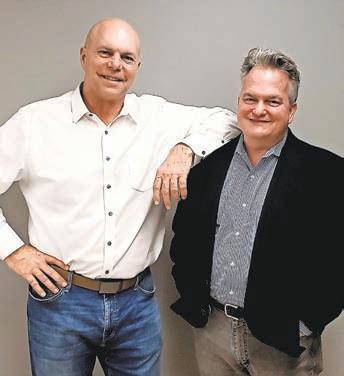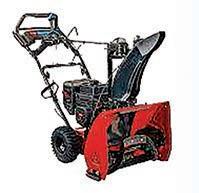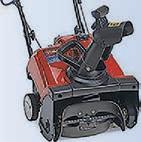



















As I write this column, New York is on the verge of a historic snowstorm, with up to five feet possible in some spots. In the Illinois Valley, we’d already had one snowstorm by mid-November, although it wasn’t nearly as big as what New York residents were experiencing.
I often tell my family when we have a small snowstorm that I would rather have a massive snowstorm that dumps several feet of snow upon us. That seems like a strange statement from someone who hates snow and cold temperatures as much as I do. But snowstorms have a way of bringing people together and helping them remember what’s most important — it’s a big reality check from Mother Nature. The hustle and bustle of our daily lives come to a screeching halt, and we get creative with the food we have in our cabinets, knowing it might be days before we dig ourselves out to get to a store. We remember how fortunate we are
to have a roof over our heads.
Although I was very young at the time, I have some vague but fond memories of the historic snowstorm in the Illinois Valley in the late 1970s. I remember walking outside and the snow being super tall, and I recall my dad marveling at how much snow we had. Even then, at my young age, I knew that particular snowstorm was something special.
The thing about a snowstorm of that magnitude is that the world just seems to shut down. It’s different now than it was in the late 1970s, of course. We lived in a world that didn’t have the internet, so we weren’t reliant on it like we are today. Working remotely wasn’t a thing, so on days of a huge snowstorm, unless you lived near your workplace, you took the day off.
For kids, a snow day like that meant you didn’t have school. You were free to do what you wanted for the day, which was usually bundling
up in all the snow gear you could find and heading outside to have a snowball fight or build a snowman or fort. You’d stay outside until your gloves were soaking wet and you were so cold you could barely function. Kids these days don’t get to experience that. If a big snowstorm happens now, they have remote learning days instead.
The good, old-fashioned snow days many of us remember are becoming a thing of the past. But I’ll still spend this winter keeping my fingers crossed for an epic snowstorm my children will still be talking about decades later.
Best wishes, Shannon Serpette, Niche Editor

Boomers Today
426 Second Street La Salle, Illinois 61301 (815) 223-3200 (800) 892-6452 www.newstrib.com
Bill Andreoni refs for the kids and to stay in shape.
Not a fan of the cold? Try one of these indoor or in-car activities this winter.
‘For the love of the game’ 14 Cinotte coaches into fourth decade.
Pasta sauces that you’ll love.
Publisher Dan Goetz
Niche Editor Shannon Serpette sserpette@shawmedia.com
Regional Advertising Director Jeanette Smith jmsmith@shawmedia.com
Writers
Brandon LaChance Shannon Serpette
Photographers
Scott Anderson Shannon Serpette
Designer
Liz Klein
Published by:
‘Still kind of a rookie’ 5On the cover: Bruce and Ollie’s offers games for families to play together. PHOTO BY SHANNON SERPETTE
















































When Bill Andreoni put on his first referee shirt and blew his first whistle 27 years ago, he knew what the benefits would be. Andreoni wanted to improve the game, knew he would get a workout, and loved that the kids would get a chance to play the game of basketball.

“I got into officiating late. I was 42 years old when I got into it. I’ve only been doing it for 27 years, so I’m still kind of a rookie,” Andreoni said. “I started with basketball and got into football. I quit football after last year’s youth football season.
“I started because I was one of those parents who coached their sons in basketball. I was at St. Patrick’s (now Trinity Catholic in LaSalle) as a coach and the athletic director for a couple of years. While I was coaching, I ran into a number of officials, back in the day, who wouldn’t call a foul. They wouldn’t call anything.
“I was frustrated. I said, ‘Guys, you have to start calling that, or someone is going to get hurt out there.’ One guy said, ‘Coach, why don’t you get an officiating license?’ I said, ‘Okay, I think I will.’ That’s how I got into it because back in the day, I thought I could do a better job.”
Andreoni is originally from Spring Valley, graduated from St. Bede in 1971, and moved to LaSalle about 35 years ago, where he and his wife, Colette, raised their two sons Tony, who is now 40 years old, and Michael, who is 39. Between his two sons’ families, Andreoni has five grandchildren.
Bill
St. Bede and has lived in LaSalle for the last 35 years, puts his health and staying in shape as a top priority, just underneath his family. Even as a referee, he finds time for his five grandchildren, one of which is Alivia.

Even with his full family life, Andreoni still enjoys refereeing. And with the lack of officials coming through the ranks, Andreoni and his partner are getting plenty of court time.
“It’s not all for the kids. It’s for the kids to a point, but I want to stay healthy. I’m 69, and I want to do another season at 70,” said Andreoni. “I can still run up and down the floor with the high school kids. I think to myself about refereeing basketball as a health benefit for me.
FROM PAGE 5
“John ‘Chuck’ Deisbeck has been my partner for the 27 years I’ve been refereeing. We said we were going to do it as long as our bodies allowed. We also said we would tell each other, ‘You’re starting to slip’ or ‘I’m starting to slip.’ Then we’d get out.
“But we got into officiating because we wanted to give them an effort. We want to run up and down the court. You see a lot of officials walking back and forth. We can’t do that. We want to give the kids, the fans, and the coaches effort. That’s why we do what we do.”
Andreoni takes his health seriously, working out any chance he can. He has a treadmill in his basement for winter exercise and uses free weights regularly.
“It’s my priority to stay in shape and not let go,” he said.
He also feels the same about calling fouls, violations, and anything worth blowing a whistle for on the basketball court. The issue is the game, the environment, our society – everything has changed.
“I feel so bad for coaches who really want to coach. There are some that will say, ‘I want to do this for

some fun’ and they’ll do it, but they won’t really coach. The rules haven’t changed much, if ever. The ability of the players has gone down,” Andreoni said.
“There are too many kids with their thumbs on video games and phones. The kids don’t seem to be into sports. They go through a routine when it’s a sport season, and that’s it,” he said. “Back in my day, we played offseason. We kept in shape and were athletic. There was never a ballpark in Spring Valley when I was growing up that didn’t have four or five ball gloves on the fence. Someone was always next.
“Those parks are empty now. I drive by and don’t see anyone. It changed in basketball, too. The kids don’t play. I dropped my kids off at the YMCA, and they played basketball for an hour or two. That’s the biggest difference. No one takes the time anymore to work,” he said.
Andreoni said there are individuals who want to be better than average and make sure they put in the work to accomplish the mission. However, if he or she is the only one on the team playing at a higher level, it makes the basketball season difficult.
“I’ve seen it time after time, a very good athlete on a team that’s mediocre at best is frustrated,” Andreoni said. “They don’t know what to do,
and they quit because they don’t have the kids around them. The kids around them didn’t care to work as hard.
“I live by that statement. I see it all the time. Kids don’t put in the work anymore, and the level of basketball has gone down. If I were a parent now, raising a child, I’d go around our small community and check out every kid at every grade school and get the kids who are putting in the work together at one high school to be on the same team because it is that bad.”
We are all products of our environment. And for grade school and high school student-athletes, the environment is their parents. Andreoni said he has seen changes over the years in the bleachers as well.
“The attitude of the kids and the attitude of the parents has changed. There are parents that came from the next generation that have kids in grade school where it’s ‘My little Tommy, my little Sally, they’re the best.’ But they’re not. Those are the ones that have really changed the environment,” he said. “Those are the ones who are screaming and yelling at officials and coaches because their son or daughter isn’t playing or an official called a foul on them.”
Although there are some changes he’d like to see, Andreoni understands where it stems from, wanting to be the best. Just like he wants to be the best official on the basketball court or part of the best officiating team. And, how he wants to be the best for his five grandchildren – Livy, Avery, Addie, Urban, and Santino.
Andreoni hopes the next wave of officials take the same principles and standards and help carry the game to
The Andreoni family doesn’t only spend their time in gymnasiums. On the holidays and any day he can, Bill Andreoni is with his grandchildren (left to right), Alivia “Livy,” Avery, Addie, Urban, and Santino.

new heights moving forward.
“I would like to see more young people become officials. I have had the pleasure of working with a few younger officials. A couple of them were very good. We have a good group that Jim Knauf takes care of as an assigner in Ottawa. We have a great group, and I hope the younger ones stay,” he said.
“I don’t know if they’re tough enough to handle the fans,” he added. “When a fan gets out of line with us, Chuck and I handle it with comedy. We are here to referee a game kids play, not argue with fans in the stands.”
I would like to see more young people become officials.
I have had the pleasure of working with a few younger officials. A couple of them were very good. ... I hope the younger ones stay.
Bill Andreoni















If you’d like to hibernate all winter just so you miss out on the plunging temperatures and icy roads, you’re not alone. It can be tough to get through an Illinois winter. But staying inside your home all the time can lead to feelings of loneliness and isolation, and after a while, you might start to get a serious case of cabin fever.
To help get you through dreary winter weather until spring arrives, here are some activities you can do from the warmth of your car or by heading indoors.
The Illinois Valley has no shortage of restaurants, so no matter what kind of food you’re in the mood for, you’ll be able to find it. Every village or city in the region has a hidden gem or two, as well as well-known local favorites. If you want to visit a historic restaurant that makes you feel like a kid again, you have several options.
Longtime favorites like Verucchi’s Ristorante in Spring Valley and The Igloo in Peru are excellent stops, with many customers remembering eating there with their own parents when they were children. Verucchi’s has been serving their renowned Italian cuisine for more than 100 years, and The Igloo first opened its doors in 1937.
WARM UP WITH A DRINK
Nothing can warm you up faster in cold weather than a cocktail or alcoholic beverage. And when you’re in a cozy environment with lots of people to talk with, like a local pub or bar, the friendly surroundings can take

The entryway into Verucchi’s Ristorante pays tribute to Elizabeth and Battista Verucchi, who founded Verucchi’s Ristorante in 1914. This restaurant has been a favorite for generations of families who stop by for great food and bonding time.

your mind off the chill outside.
The Illinois Valley has several places you can find conversation and drinks,
Not a fan of the cold? Try one of these indoor or in-car activities this winter
FunFROM PAGE 9

like the Barrel Society in Princeton, a favorite of locals and out-of-towners. If you’re looking for a drink that will quickly warm you, Barrel Society owner Nick Gorogianis offered some suggestions.
“I would suggest any one of our hand-selected, single barrel whiskeys. Whether it’s bourbon or rye, our selection process is long and meticulous, and we will only put the Barrel
Left: The Barrel Society, located in Princeton, can warm you up this winter with a wide selection of your favorite drinks, including an extensive menu of craft beers.

Society name on the best of barrels. Bottled at cask strength, and loaded with flavor, our single barrel whiskeys are sure to warm you up, even on the chilliest of days,” Gorogianis said.
If you’re in LaSalle, you’ll find a wide drink menu at 9th Street Pub, a well-known local hangout that features frequent live music, shuffleboard, video poker, jukeboxes, darts, and more.
If local wine is your thing, August Hill Winery is an excellent stop to make in Utica. You can order a wine flight and sit and sip with your friends.

Things look much different in the Illinois Valley in the winter compared to summer, spring, and fall. The historic Red Covered Bridge in Princeton is one of those spots that takes on a different sort of charm in each season. Take your kids for a drive past the bridge and ask them to share their thoughts about what life was like when this bridge was constructed in 1863. This quiet time in the car might spark some interesting conversations, and it can serve as bonding time for the whole family if you leave the electronics at home.
For parents or grandparents who grew up in the Illinois Valley and no longer live in their childhood home, their children and grandchildren might enjoy driving past that old home. As you drive, you can share some of your favorite memories of living in that house and stories about your other family members. It can

help the younger generation feel closer to members of their family they may have never met.
The whole Illinois Valley region is rich in local history, and you’ll be able to enjoy several stops during the winter to share with visiting friends or family if you’d like.
The Hegeler Carus Mansion in LaSalle offers tours of varying lengths, and the tales of local history will make you forget the weather outside. The origins of this house begin with German immigrant Edward Hegeler, who settled in LaSalle and began a business, the Hegeler-Matthiessen Zinc Company, with his business partner and friend, Frederick William Matthiessen, in 1858.
“It’s no exaggeration to say that there are artifacts here that rival those in more nationally known museums like The Smithsonian,” Tricia Kelly,

FROM PAGE 11
the tour director of Hegeler Carus Mansion, said recently during an interview.
Reddick Mansion in Ottawa is another local gem. This 22-room Italianate mansion is wonderful to visit all year round.
Superintendent of Recreation for the Princeton Park District/Bureau County Metro Center.
“We offer a number of group exercise classes in the morning and evening time that fit many different schedules. Our 52,000-square-foot facility houses a cardio room, weight room, and functional training room. We have equipment and space to fit all fitness levels,” Davis said. “We offer many different membership options and day passes for non-members. We’re open Monday-Thursday, from 5:30 a.m. - 8:30 p.m.; Friday, 5:30 a.m. - 6 p.m.; Saturday, 8 a.m. - 5 p.m.; and Sunday, 10 a.m. - 2 p.m. Please stop by our family-friendly facility to warm up this winter season.”
it’s easy to be come more sedentary than you are the rest of the year. It can be so cold and dreary outside that you’d rather watch a movie than go for a walk or run outside. But with access to one of the area’s several gyms, like the Illinois Valley YMCA in Peru or the Bureau County Metro Center in Princeton, you can get top-notch workouts inside in the warmth. And once you start moving around, you naturally feel warmer.

Newcomers are always welcome at both places, where they can take advantage of all the equipment and group fitness classes.

“Warm up in our sauna and jacuzzi area, swim laps in our six-lane pool, enjoy open swim time or one of our morning water fitness classes,” said Nick Davis, Assistant Director and
There are several libraries throughout the Illinois Valley, and they all offer much more than just books. Many of them offer an interesting mix of programs and events that are geared toward people of every age. Give them a call or check out their websites to learn about any special programs coming up.
If you’re already feeling the financial strain of holiday spending, this will be a cheap option for some entertainment.

As we age, we lose one teaspoon of collagen in our face every year. Collagen is the main protein in our skin that gives us a youthful look. By the age of 35, we have lost 15% of our facial collagen, by the age of 45 you can expect to have lost 25% of your facial collagen and by the age of 55, we have lost 35% of our collagen. Collagen makes up around 75% of your skin and replacing what we have lost is a key component to a younger-looking countenance.
There are many anti-aging procedures that can help stimulate the body to produce new collagen, but there are few than can efficiently create it in the exact places we need it like Sculptra can. Sculptra, an FDA-approved cosmetic medication, consists of poly-L-lactic acid and is injected into the skin in areas where collagen loss is the most pronounced. It creates a scaffolding that our own collagen can attach to and becomes Type 1 collagen. This new collagen matrix, strategically placed by a skilled cosmetic injector, can lift the face and also improve the appearance of fine lines, wrinkles and laxity.
As with other cosmetic procedures that promise to turn back the hands of time, we asked Dr. Norris at Nicole Norris MD Medical Spa in Peru, Illinois to weigh in on Sculptra and its anti-aging effects.

Do you use Sculptra at your medical spa and how exactly does it work? “Sculptra is an FDA- approved injectable collagen biostimulator that works deep in the skin to improve its inner structure. Sometimes I describe it to my patients as a fertilizer for collagen production. It is not a filler and it always gives a natural result. I like to use it in key areas of the face where collagen loss is most apparent like the cheeks, temples, lower face and jaw line. It does a great job of not only lifting sagging areas of the face, but also improving fine lines and the overall skin appearance. Often patients comment on their postSculptra glowing skin.”
How many treatments are needed and when can a person expect to see results? “The active ingredient in Sculptra, poly-L-lactic acid (PLLA) is a plant-based material proven safe for decades and is mixed with sterile water. I like to inject 1-2 vials at a time and recommend 1 vial for every decade of life. For some patients it may take 4 sessions or up to 6 vials of Sculptra to get the correction that they need. I usually wait 8 weeks between sessions and tell patients they will not see a result until at least 8-12 weeks after each treatment. Our own bodies create collagen slowly, and unfortunately, the older we are, the slower the process.”
Are there side effects and who is a good candidate? “Sculptra is typically injected into areas of the face with a needle, so there is a risk of bruising with the procedure. If a patient is allergic to suture material, it is not a good
idea to have Sculptra, as PLLA is often found in the same material used to sew cuts in the skin. Immediately after having Sculptra placed in the skin, there is some swelling of the areas injected because of the sterile water component. This puffy look resolves in a day or two, but any bruising can take 10-14 days to resolve. Anyone who is aging and is bothered by the appearance of falling cheeks, jowls, and overall loss of a youthful appearance is a good candidate. Patients who have autoimmune disorders or who are ill are not good candidates as their bodies will likely not produce the collagen expected.”
How long will the results last? “The clinical studies on Sculptra were carried out for two years and 100% of patients were happy with their results at 24 months. However, we know that Sculptra creates Type 1 collagen which has been shown to last 5-10 years depending on a person’s habits like smoking and sun exposure. Sculptra gives natural looking results that gradually reveal themselves. It is a great anti-aging procedure on its own or used in conjunction with other anti-aging procedures (i.e. peels, lasers, microneedling), dermal fillers or Botox. I strongly encourage my patients to do procedures that replace the collagen that they are losing every year. This is the best way to look naturally rejuvenated, prevent the signs of aging, and not need as much filler or cosmetic surgery procedures down the road.”
If you are interested in learning more about Sculptra or other anti-aging procedures, call Nicole Norris MD Medical Spa for your personal consultation with Dr. Norris at 815-780-8264 or follow them on Instagram or Facebook.
You’ve heard the saying or phrase, ‘For the love of the game,’ before. Sometimes, it sums up a two-hour contest. It could wrap up a season, a four-year junior high career, a fouryear high school career, or a career that expanded into college and to the professional ranks.

Pat Cinotte has loved the game of basketball since he came across it. He has carried the love via coaching into four decades as he has been on the sideline as an assistant with the Illinois Valley Men’s basketball team, a head coach with the DePue
High School boys team, head coach with the Hall High School Lady Red Devils, the lead man with the IVCC women, and is currently running an AAU (Amateur Athletic Union) squad, the Illinois Valley Warriors.
“I just have a love for the game, and I knew a lot of people involved in basketball,” said Cinotte, who actually has 12 teams, both boys and girls, with the Warriors. “Now, it’s just keeping up with all of my old contacts and going to different places and watching a lot of the college coaches that have helped me through.
Above: The Illinois Valley Warriors surround coach Pat Cinotte as he breaks down the game plan.
“The other night, I was texting Doug Collins, the former Bulls coach about the Bulls. I know a lot of people, and I stay in contact with a lot of people. I go to a lot of practices and a lot of games every week.”
Cinotte, who hit year 31 as a coach this summer, is at five or six games a week. He has been for all of those 31 years as he has been scouting players to recruit or teams he would face. Since he has coached at the high school, junior college, and AAU levels, Cinotte knows firsthand about the pros and cons of club sports.
“The main focus of AAU is to try to play against the best players in the country and to get to the next level to play Division I, Division II, Division III, or NAIA,” Cinotte said. “The problem is college coaches only have so many times they can go on the road. They’ll spend a lot of time in April, May, June, and July on the road. But there are only certain weekends and contact days they can use for recruiting. They go to AAU tournaments where there are 200 teams. Chicago has the biggest tournament, where 1,000 teams from all over the country play at the United Center.
“It’s by far easier to get college coaches’ attention
thing when you’re looking at our area – I’ve been coaching for 31 years and see a lot of kids – sometimes you have to evaluate and say, ‘What can this kid do at the next level? I know he scored 20 points a night here locally, but can he score that at the next level?’
“Also, what position would the player play? Some of these high schools need the players to play at different positions. That’s not where they’re going to play at the next level. That’s very tough, too, where we have kids playing a position all summer with the Warriors, then they go back to their high school team and they’re playing a different position. It hurts them, and it hurts the team,” he said.
The Warriors had a game last season where over 30 coaches were in the building.
And every single player was amped up to play well because they saw the college logos on the polos and the hands around the clipboards.
“In high school, you may not want a college coach to come watch a game against other teams they’re playing,” Cinotte said. “You wouldn’t want to waste one of a college coach’s recruit-


FROM PAGE 15
ing days on a 50-point rout. That’s the reason you rarely see college coaches at high school games.”
“College coaches also don’t want to use a contact day on one player. They’d rather spend it watching 6-10 games where they can see 20-30 players that all have potential at the next level,” he added.
At any level, Cinotte has seen the changes with his own eyes. He recognizes AAU, where he has coached for the last six years, has a lot to do with it, both positively and negatively.

“The game has changed so much. You don’t want to say for the good or the bad because it’s tough. Kids need AAU, but I will say back when I played, we didn’t have AAU. We all played as a team and were one team,” Cinotte said. “Now, you have
kids missing games or not going out for sports at their schools because of clubs and AAU. I was at a game recently, and one of the better players was at a softball tournament.
“When I was growing up, we were all a team. We played as a team. Now, parents and players, they’re all for themselves. It has affected officiating. It has affected coaches. It has affected everybody. There isn’t much team anymore. It’s about the individual because a parent has money wrapped into club or AAU sports and wants their child to outperform everyone on the court, even their teammates. The cheering used to be toward everyone in the same color jersey as their child. Now, it’s just for their kid.”
Cinotte cited that situation and a few others as to why he will not go back to high school coaching.
“I don’t think I’ll ever get back into high school coaching. I may get back into junior college coaching,” Cinotte
said. “There are too many situations right now with parents, coaches, and officiating. Back in the day, we didn’t care that much about the calls or the whistle. Now, everyone is after everyone. It goes back to, ‘I have to make sure my kid performs well today. You’re the problem, referee. You’re the problem, coach.’

“I’ve seen where kids don’t get college scholarships because of parent behavior. When I was coaching at IVCC and went out every night looking at kids, the first thing I wanted to know was who are the kid’s parents. I kept my eye on them and how they acted,” Cinotte said. “That’s what some of these parents don’t realize. The parent comes with the kid. Do I want them at every game? Do I want them calling me every day? You’re

recruiting the kid, but you’re also recruiting the parents.


“At the AAU level, when there are college coaches in attendance, I get, ‘My daughter didn’t play enough. She needed to play more.’ So, you’re never making everyone happy. That’s just the flips and the grind,” he said.

Although he has seen all of the good and the bad, Cinotte comes to the gym every day ready to coach.


“What’s kept me going is the love of the game, and I love helping the kids,” Cinotte said. “Nothing makes me happier or more excited than when I have former players contact me and say, ‘Hey, this is what I’m doing now.’ Or when I see players getting a scholarship to play somewhere. That’s my reward, and that’s what I love.”

“What’s kept me going is the love of the game, and I love helping the kids.”Patrick Cinotte


















When it’s cold outside, sometimes all you want to do is sit on your couch and watch a movie while you eat a big, steaming plate of pasta. Or perhaps you’re trying to save money for the holiday season by finding inexpensive dishes to make at home.

Luckily, there are so many great and easy-to-make pasta sauce recipes out there that you’ll quickly find one you can make at home. Since pasta is highly affordable and a single box can feed multiple people, it’s economical too. From white sauces to red, this list will give you several new sauces to try. One of these just might become your new favorite.

1/2 cup butter
1 pint heavy whipping cream
4 ounces cream cheese
1/2 teaspoon minced garlic
1 teaspoon garlic powder
1 teaspoon Italian seasoning
1/4 teaspoon salt
1/4 teaspoon pepper
1 cup grated Parmesan cheese or white pizza blend cheese (can use 2 cups if you want)
Boil water and cook whatever pasta you’d like to eat. Set the pasta noodles aside until the sauce is ready.
In a medium saucepan, add butter, heavy whipping cream, and cream cheese. Cover over medium heat, stirring or whisking until melted. Add the minced garlic, garlic powder, Italian seasoning, salt, and pepper. Continue to whisk or stir until it’s smooth. Add the grated cheese, bring to a simmer, and cook for 3 to 5 minutes or until thoroughly melted and thickened.
Add the sauce over your prepared pasta noodles. It’s also excellent with broccoli and chicken mixed in with the pasta and sauce.

Salt
2 large eggs and 2 large yolks 1/2 cup grated pecorino Romano, plus extra for topping 1/2 cup grated Parmesan Coarsely ground black pepper 1 tablespoon olive oil 3 and 1/2 ounces of bacon, sliced into bite-sized pieces 12 ounces spaghetti

Put a large pot of water with a half tablespoon of salt over high heat and bring to a boil. In a mixing bowl, whisk the eggs, yolks, and cheeses together, and add a pinch of salt and black pepper.
As the water begins to boil, heat olive oil in a big skillet over medium heat, add the bacon, and sauté until it’s on the edge of crispiness. Remove the bacon from the heat and set it aside.
Once the water is boiling, add the pasta to it and boil until it is al dente. When it’s done cooking, drain the pasta, saving one cup of the pasta water, and then add the pasta to the bacon skillet. Cook over low heat for a couple of minutes, stirring the mixture together. Pour the bacon and pasta mixture into a serving bowl. Stir in the cheese and egg mixture into the serving bowl, putting a little pasta water into the sauce if you want it to be creamier. Add a little extra cheese over the top and serve immediately.

Salt and black pepper
One pound of pasta of your choice

1 tablespoon extra-virgin olive oil
2 tablespoons butter
3 cloves garlic, minced
1/2 large onion, diced
One 16-ounce jar roasted red peppers, drained and chopped
1 cup vegetable or chicken broth
1/4 cup heavy cream
2 tablespoons parsley
Fresh basil, chopped (dried if no fresh basil is available)
1/2 cup grated Parmesan
Bring a big pot of salted water to a boil. Cook the pasta according to the directions on the package. When the pasta is cooking, add the oil and butter to a large skillet over medium-high heat. Add the onions and garlic and sauté for two or three minutes. Add the chopped red peppers and cook for another three minutes.
Move the contents of the skillet to a blender and puree until it is totally blended but still slightly textured. Transfer the puree back to the skillet, add the broth, 1/2 teaspoon of salt, the desired amount of pepper, and stir until heated. Add in the cream and stir it until combined. Add the parsley and basil and stir.
Drain the cooked pasta and add it to the skillet. Add in the Parmesan, and stir everything in the skillet together. When serving, top with additional seasonings or cheese if desired.

5 pounds ground chuck
1 cup chopped onion
2 tablespoons cooking oil
1 cup tomatoes, fresh, canned, or frozen
5 small cans tomato paste
1 clove garlic, crushed
3/4 teaspoon basil
3/4 teaspoon sage
3/4 teaspoon Italian seasoning
3/4 teaspoon rosemary
Sauté the onions in oil in a large pan. Add the meat and cover with a lid. Cook until the meat is brown. Drain excess grease from the meat, and add tomatoes, tomato paste, and seasonings. Add salt and pepper to taste. Put in three cups of water, stir, and then cover. Cook on low heat for at least four hours, stirring occasionally. You can freeze the excess pasta sauce for a later date.
8 ounces spaghetti
1/3 cup extra virgin olive oil
5 cloves garlic, thinly sliced
1/2 teaspoon crushed red pepper flakes (can use more or less depending upon heat tolerance)
1/2 cup chopped parsley
1 tablespoon fresh lemon juice
1/2 cup grated Parmesan cheese
Salt and pepper
Bring a large pot of salted water to a boil. Add the pasta and cook according to the instructions on the package until al dente. Drain, reserving one cup of the cooking liquid for later use.

While the pasta is cooking, heat the olive oil in a skillet over medium heat. Add the garlic, cook, and stir until it is tender and lightly browned. Stir in the crushed red pepper. Add pasta and remove from heat, tossing gently. You can add some of the reserved liquid to reach the consistency you want.
Add the parsley and lemon juice and toss again. Season with salt and pepper, and serve with the grated cheese.




If you are already enrolled in the current MyCare Patient Portal from St. Margaret’s Health – Spring Valley, your existing credentials should grant you access to the updated portal. Your credentials to the former Illinois Valley Community Hospital (IVCH) portals (or, St. Margaret’s Health – Peru), will NOT grant you access, and you will need to enroll using one of the methods below.


1 Any St. Margaret’s Health staff member with Meditech access at Registration or when checking in for an appointment can send a link via e-mail with an invite to the portal.

2 Existing patients who have already had a visit with St. Margaret’s Health – Spring Valley, and therefore an assigned Medical Record Number (sometimes referred to as an “M number”), as well as a valid e-mail address associated with the patient account, may self-enroll online at smhportal.meditech.cloud
A valid e-mail address (again, that is already associated with your assigned Medical Record Number) is required to sign up for the portal.

Existing and new patients alike can easily enroll in the portal. Here are the ways in which a patient can become enrolled in the MyCare Patient Portal: